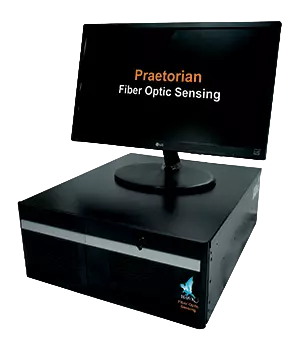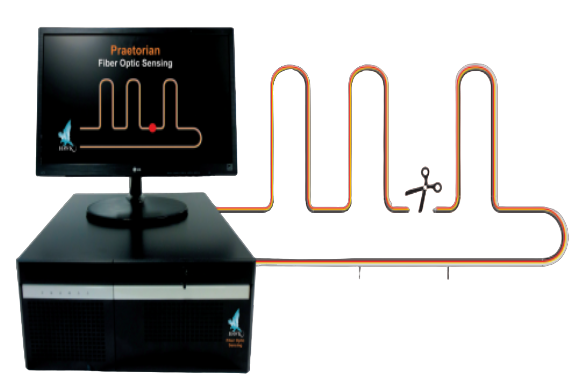
Perimeter Security & Threat Detection
Using a combination of Rayleigh backscatter and time of flight,
Praetorian determines the presence, location, intensity and
frequency of vibrations along an optical fiber in real-time.
Rayleigh backscatter responds to physical vibrations imparted on the fiber by
disturbances to the application. HAWK’S signal
analysis software allows Praetorian to quickly determine the most likely origin of
the vibration and report any nefarious signals to
security personnel without notifying an intruder of their detection.
The location of vibration is determined using a “Time of Flight” calculation. When a
laser pulse is emitted from the system a very fast
clock is started. As backscattered light returns to the detector they are recorded
for further analysis and time stamped. Due to
the speed of light being constant within a fiber (approximately two thirds of normal
light speed) this timestamp corresponds to a
distance on the fiber.
Primary Areas of Application
Installation locations:
- Army barracks
- Airports
- Prisons
- Explosive storage areas (Magazines)
- Country borders
- Hazardous areas
- Unmanned sites
Applications::
- Cyclone fence perimeter
- Concrete, block or brick wall perimeters
- Covert subsoil installation
- Sterile zone monitoring
- Gate traffic monitoring
- Border protection
- Barbed or concertina wire
- Security patrol tracking
Perimeter Security & Threat Detection Function
Praetorian acts as an infinite series of microphones within the
fiber recording in real-time. The system analyses an enormous
amount of data using ultra fast FPGA architecture to give real-time feedback on the likely origin and type of the disturbance.
Utilizing proprietary pattern recognition software Praetorian
reduces the incidences of false positives normally associated
with other Fiber Optic Sensors.
Praetorian uses a series of pattern-recognizing modes to detect,
identify, and report nefarious movements at, on or around the
perimeter being monitored.
Multiple outputs are available from simple Alarm/No-Alarm
States to full digital integration such as Modbus over Ethernet
and can be fed directly into existing DCS and SCADA control
systems for high-speed integration. Alternatively, Praetorian can
be operated directly with a keyboard and mouse through the
units inbuilt Human Machine Interface (HMI).
Praetorian’s fast processing speed and pulse rate allow it to detect minute interferences that may otherwise go unnoticed. Some examples of detectable activities include:
- Intruder movement along a perimeter
- Intruder movements either side of a perimeter via covert sub terrain detection (Intruders cutting a fence)
- Intruders climbing a fence
- Vehicle movement along a perimeter
- Digging, excavation, trenching and undermining
Unique Features

Additional Features of Perimeter Security & Threat Detection
- Standalone hardware capable of detecting and generating alarms
- Multi-sensing capability - DAS (Acoustic) + DTS (Temperature) + DSS (Strain)
- Multivariable analysis minimize false positives
- Automatic signal calibration
- System interlock - optional laser shutoff in case of cable break
- End of fiber detection to ensure fiber length
- Real time fiber + connector quality monitoring
- Temperature compensation over full fiber length
- Dynamic threshold in 250mm segments
- Independent detection algorithms for static & motion tracking signals
- 64 Bit high speed FPGA architecture
- GIS integration capability
- 48 point on-board multifunctional self-diagnostic feature
- Adjustable pulse width from 10ns to 295ns
- Very high extinction ration (more than 80dB)
- Monitors gate open / close activities and vehicle movement

